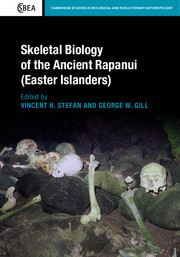Book contents
- Frontmatter
- Contents
- List of contributors
- Acknowledgements
- 1 Introduction: Research overview
- 2 Review of Polynesian and Pacific skeletal biology
- 3 Chronology and Easter Island prehistory
- 4 A descriptive skeletal biology analysis of the ancient Easter Island population
- 5 Craniometric variation of the prehistoric Polynesians and Rapanui
- 6 Rapanui non-metric cranial traits
- 7 Intra-island discrete cranial trait variation
- 8 Continuous non-metric characteristics of the early Rapanui
- 9 Rapanui dental morphology
- 10 Pelvic variability and sexual dimorphism in prehistoric Rapanui
- 11 Genetic affinities of the Rapanui
- 12 Archaeogenetics and paleodemographic estimation of founding populations: Features of residential geography on Rapa Nui
- 13 Evidence for injuries and violent death
- 14 Demographic analysis of modified crania from Rapa Nui
- 15 East Polynesian and Paleoindian parallels and contrasts in skeletal morphology
- 16 Rapanui origins, relationships, and warfare: A summary in theoretical context
- References
- Index
1 - Introduction: Research overview
Published online by Cambridge University Press: 05 December 2015
- Frontmatter
- Contents
- List of contributors
- Acknowledgements
- 1 Introduction: Research overview
- 2 Review of Polynesian and Pacific skeletal biology
- 3 Chronology and Easter Island prehistory
- 4 A descriptive skeletal biology analysis of the ancient Easter Island population
- 5 Craniometric variation of the prehistoric Polynesians and Rapanui
- 6 Rapanui non-metric cranial traits
- 7 Intra-island discrete cranial trait variation
- 8 Continuous non-metric characteristics of the early Rapanui
- 9 Rapanui dental morphology
- 10 Pelvic variability and sexual dimorphism in prehistoric Rapanui
- 11 Genetic affinities of the Rapanui
- 12 Archaeogenetics and paleodemographic estimation of founding populations: Features of residential geography on Rapa Nui
- 13 Evidence for injuries and violent death
- 14 Demographic analysis of modified crania from Rapa Nui
- 15 East Polynesian and Paleoindian parallels and contrasts in skeletal morphology
- 16 Rapanui origins, relationships, and warfare: A summary in theoretical context
- References
- Index
Summary
The mysteries of Easter Island (Rapa Nui) have gripped the imagination of explorers, scientists, and the public for more than a century. The origin of the Rapanui people and the rise and fall of their advanced prehistoric culture raise many important scientific questions. Who were the Rapanui ancestors? Did they come to this remote island as part of a single Polynesian migration or multiple ones? Were all of these early inhabitants Polynesian or were some of them of South American origin? What forces were involved in the rise, decline, and eventual collapse of this unique culture? Answers to these questions could explain much about human mobility, resourcefulness, and adaptability.
Explorations of Easter Island within the modern era began largely with archaeological investigation. Beginning with the Norwegian Expedition of 1955–56, under the direction of the world-famous explorer, Thor Heyerdahl, an international team of archaeologists began the process of scientific inquiry (Heyerdahl and Ferdon, 1965). They excavated a number of well-documented sites, and at most of them encountered well-preserved human skeletons. Thousands of additional human bones were seen by these archaeologists since they existed in open caves and partially exposed burial chambers within ahu platforms (i.e., the platforms that support the giant Easter Island statues, or moai). These men realized the importance of human skeletons to future scientific investigation, and also the risk of their loss in the not too distant future as this tiny island would most certainly, in time, begin to open up to the outside world.
The 1981 Easter Island Anthropological Expedition, which resulted in the successful recovery, protection, and initial study of these threatened human bones, and which eventually allowed for many of the studies presented in this book, was inspired and assisted in many ways by these members of the original Heyerdahl team (especially William Mulloy, Gonzalo Figueroa G-H, and Thor Heyerdahl himself). This connection will be discussed in more detail below.
- Type
- Chapter
- Information
- Publisher: Cambridge University PressPrint publication year: 2016



